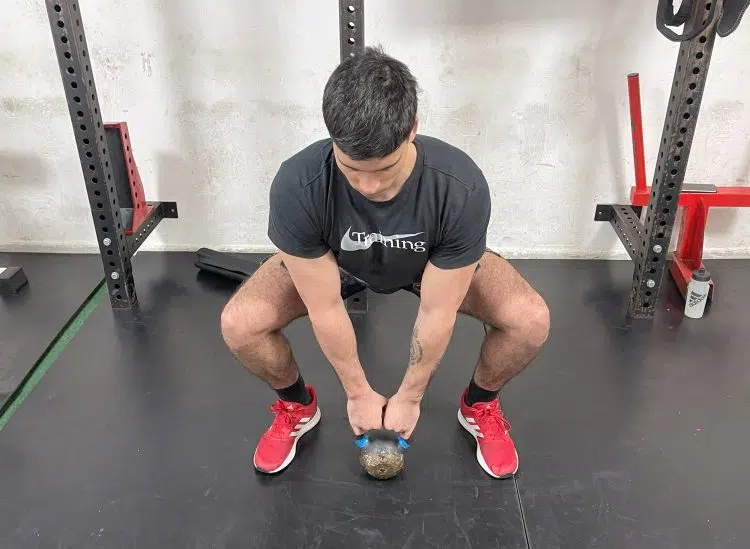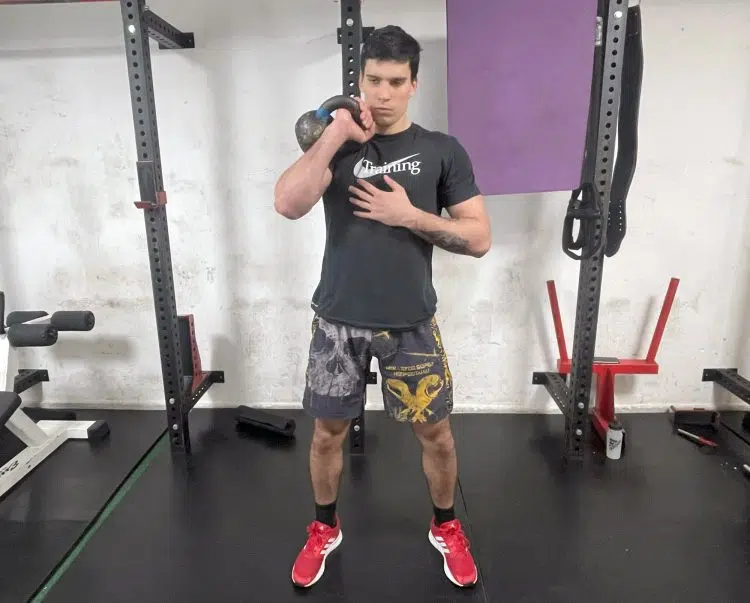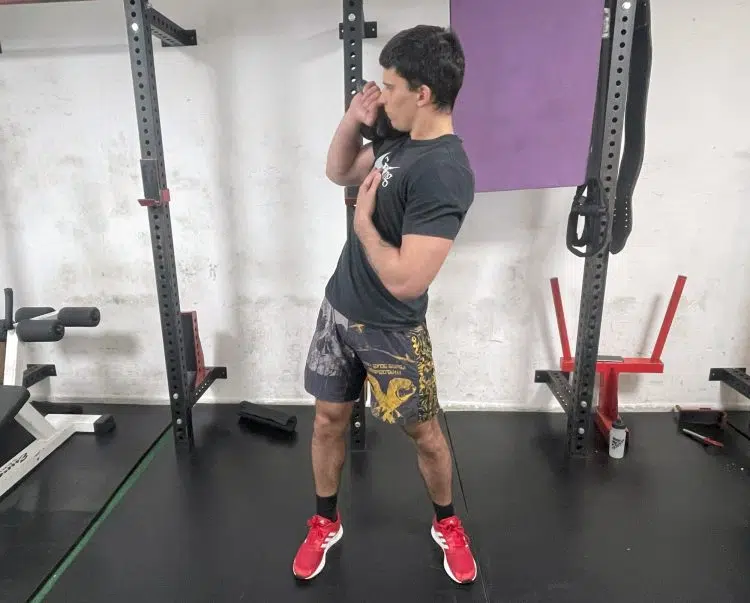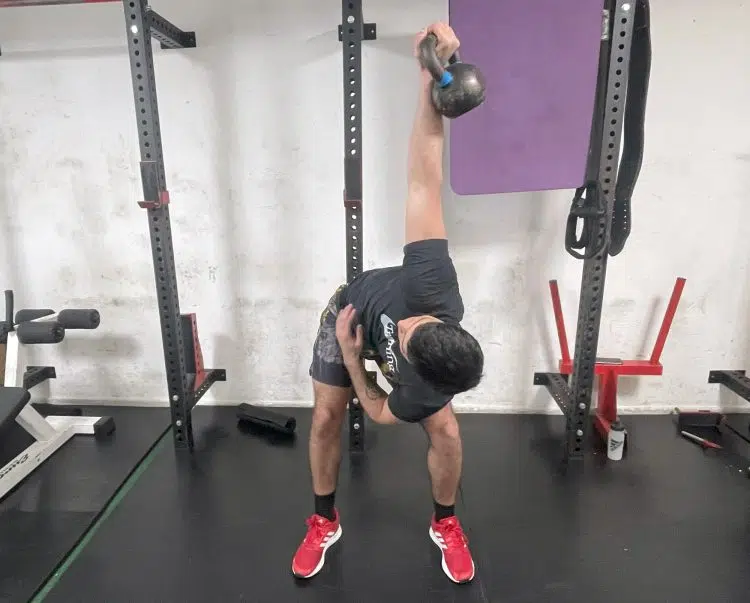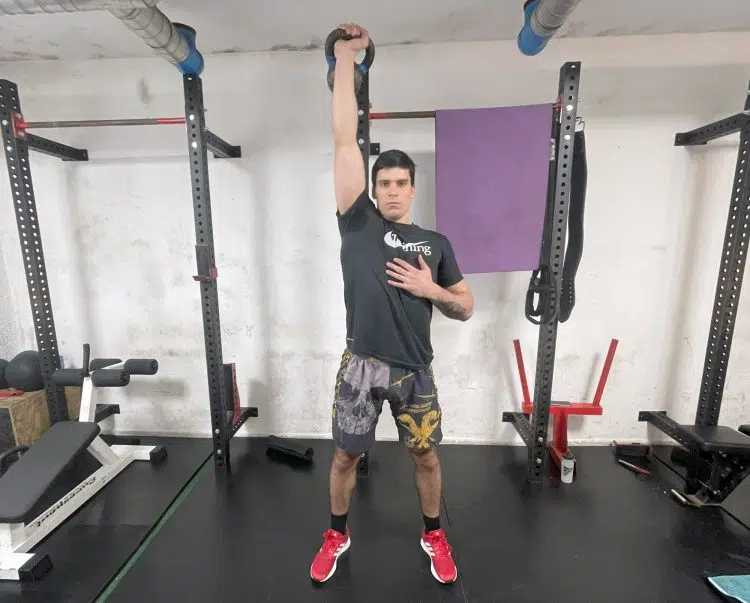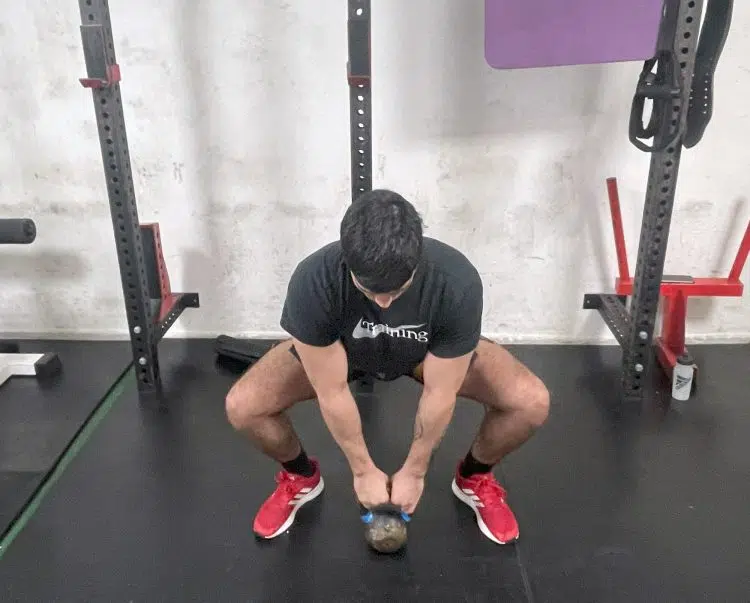Old-time strongmen Arthur Saxon and Sig Klein heavily used the bent press. Dave Whitley’s book, Taming the Bent Press (2014), offers a comprehensive bent press guide and dives deep into how these two strongmen had completely different forms and techniques for the same exercise.
The bent press is excellent for developing thoracic mobility. A study in Medical Science Monitor suggests that thoracic spine mobility exercises can reduce pain in office workers with non-specific chronic neck pain (1).
I spent over 40 hours researching the bent press, from its origin to the most effective lifting technique, and I’ll pass down everything I learned in this article.
Step-By-Step Bent Press Guide
Here is a detailed guide to mastering the bent press with a kettlebell. You can also use dumbbells or barbells, but I suggest initially using the kettlebell to drill the movement mechanics. Dumbbells and barbells are more unstable. However, they will be covered under the variations and alternatives section.
Step One — Assume the Starting Position
Pick the appropriate kettlebell. Start with a lighter weight to learn the movement pattern first.
Assume a shoulder-width stance with your feet. Bend down and grab the kettlebell handle with both hands as if you would perform the kettlebell swing exercise. Make sure your back is straight, and you are looking straight ahead.
Pro Tip: Experiment with different stance widths until you find what works best for you.
Step Two — Clean the Kettlebell to the Front Rack Position
Swing the kettlebell slightly forward and immediately back between your legs as if you would perform the kettlebell swing. As you return the kettlebell towards your body’s front side, clean it to your right shoulder.
So, swing the kettlebell with both hands and, at the last moment, catch it with your right hand in the front/side rack position on your right shoulder.
Pro Tip: Use your hips to swing the kettlebell to the front rack position. This will help generate greater force and speed, allowing you to easily clean the kettlebell to your working shoulder.
Step Three — Twist Your Body
First, open your left foot slightly outward and your right foot inward. Twist your thoracic spine and perform lateral trunk flexion towards your left knee. Imagine you want to rest your left elbow on your left knee and then just add the rotatory component.
Pro Tip: Contract your obliques and hips muscles at the end range of motion to ensure better balance and stability. Look at the kettlebell during this step. However, if that goes against your overall stability, ignore it.
Step Four — Fall Away From the Weight
Fall away from the weight while retaining the distance between the kettlebell and the floor. Slowly tuck under the weight and bend towards your left leg from your hips. Simultaneously bend your hips and knees until your working elbow is fully extended and the arm is perpendicular to the floor.
Pro Tip: The taller you are and the longer arms you have, the greater the need to bend your knees. Focus on bending primarily at your hips (hip hinge movement), ensuring that it does not compromise the integrity of your lumbar and thoracic spine.
Step Five — Extend Your Legs and the Kettlebell Over Your Head
Now, reverse the thoracic rotation and trunk flexion and simultaneously extend your knees and hips to return to the upright position. Ensure your working arm remains perpendicular to the floor throughout this step.
Pro Tip: Focus on shoulder stability during this phase to ensure the kettlebell remains stable and doesn’t cause full-body instability.
Step Six — Return the Kettlebell to the Floor
Slowly return the kettlebell to the floor. Avoid dropping it to the ground. I usually lower the kettlebell between my legs before returning it to the floor.
Pro Tip: Focus on absorbing as much force as possible on eccentrics by contracting your posterior and lower body muscles.
Bent Press Muscles Worked
The primary muscles worked during bent presses include obliques, lats, and triceps.
The secondary muscles include the gluteus maximus, quadriceps, hamstrings, deltoids, core, and forearm muscles.
Bent Press Benefits
Here are the most important bent press advantages:
Shoulder Stability and Strength
The bent press can help develop your shoulder stability and strength, which are crucial for injury prevention, especially among elite athletes.
Core Engagement
You must engage your core muscles, including rectus abdominis, obliques, transversus abdominis, and additional posterior chain hip muscles, to perform the bent press correctly. This will result in a holistic core engagement, leading to stronger ab musculature.
Unilateral Training
Unilateral training is often overlooked. Not only is unilateral training crucial for improving single-limb strength, but it is also essential for developing functional strength. Plus, sports like basketball, football, and handball rely heavily on unilateral strength for optimal performance.
There is also substantial evidence suggesting that unilateral training is highly effective for individuals with single-limb injuries. Studies show exercising the healthy limb can lead to improvements on the injured side (2).
Total Body Workout
The bent press trains your full body. It activates everything from your lower body and core to your upper body and neck muscles. This is why you shouldn’t perform bent presses towards the end of the workout.
Bent presses require substantial muscle synergy. Performing this exercise at the beginning of a workout, when the central nervous system (CNS) is fresh, can help boost performance.
Functional Movement
The bent press is a compound movement involving multiple joints and muscle groups. It combines different movement patterns, making it one of the most functional movements.
Tips For Bent Press
After a dozen client sessions and classes teaching the specifics of the bent press, I have singled out the most useful tips to perform this exercise correctly. These may seem very simple and blunt initially. Still, mastering the basics will ensure you perform the movement safely and progress quickly.
Start Light
Always start light, especially when you are performing a movement for the first time. The goal of starting with a light weight is to drill the movement mechanics and technique before progressing to heavier weights. This will drastically lower your chance of injury.
Perform a Proper Warm-up
Never perform the bent press without a proper warm-up. The warm-up should include some kind of cardio to elevate your heart rate and core temperature and dynamic movements to prepare your muscles and central nervous system for the complex movement ahead.
Rotate From Your Thoracic Spine
You must aim to only rotate from your thoracic spine. Rotating from your lumbar spine can cause serious injuries. The lumbar spine should be stable, whereas the thoracic spine should allow a greater range of motion and freedom of movement.
“Enhance thoracic spine rotation by actively focusing on the movement and engaging your core muscles to stabilize the lumbar spine.
Most Common Bent Press Mistakes
Here are some of the most common mistakes I have noticed people make while performing the bent press:
Improper Stance
Having too narrow or too wide of a stance can pose some stability issues. Aim for a stance that allows for as much stability as possible. For me, this is usually around shoulder width, but it may be different for you.
Lack of Shoulder Stability & Core Engagement
Failing to engage and stabilize your shoulders and core during the bent press could result in dropping the kettlebell, losing balance, or potentially causing injury. Practice holding the kettlebell in the overhead position before attempting the bent press.
Poor Hip Hinge
Poor hip bending mechanics can lead to compensatory knee and ankle movements. To fix poor hip hinge movement, you must have flexible and strong posterior chain muscles, such as the hamstrings and glutes.
Bent Press Variations & Alternatives
Here are some of the best variations and alternatives to consider:
Barbell Bent Press
The barbell bent press is a more challenging variation that involves greater instability, therefore requiring better balance and core activation.
Steps:
- Load the barbell on the floor with an appropriate weight.
- Grab one end of the barbell by the sleeve and raise it until the end cap points toward the ceiling.
- Grab the barbell at the center knurling. Position your shoulder next to your hand and slowly lower the bar onto your shoulder.
- Everything else remains the same as with the kettlebell.
Pro Tip: Perform all the phases much slower than the kettlebell variation. I find that performing each phase of the lift slowly makes the lift more stable.
Dumbbell Bent Press
The dumbbell bent press is an excellent variation. In my experience, it strikes a balance in difficulty between the kettlebell and barbell versions.
Steps:
- Pick a dumbbell of an appropriate weight and place it on the floor.
- Bend over, grab the dumbbell, and perform a clean to bring it to your right shoulder. Avoid swinging it between your legs.
- Everything else is the same as with the kettlebell and barbell variations.
Pro Tip: I find it much easier to squat while cleaning the dumbbell to my shoulder, as I can generate more force from my legs.
Turkish Get-up
The Turkish get-up is an excellent whole-body exercise that will challenge your core and shoulder stability.
Steps:
- Lie supine with a kettlebell on your right side.
- Grip the kettlebell with both your hands.
- Press it up with your right arm until your elbow is fully extended.
- Bend your right knee with your foot flat on the ground. Keep your left leg straight.
- Push off the ground with your right foot and roll onto your left elbow, keeping your eyes on the kettlebell.
- Straighten your left arm to lift your torso higher.
- Lift your hips into a bridge position, driving through your right heel.
- Sweep your left leg back, bend the knee, and position yourself into a lunge position with your left knee on the ground.
- Shift your weight forward and get into a kneeling position with your right foot flat on the ground.
- Push off your right foot and bring your left foot forward to stand up, keeping the kettlebell overhead.
- Carefully reverse the steps to return to the starting position. Repeat on the other side.
Pro Tip: To enhance shoulder stability, actively engage your shoulder muscles by pulling the kettlebell into your shoulder socket throughout the movement. Additionally, I find it quite useful to visualize drawing a straight line with the kettlebell from the starting position to the standing position. This can help maintain proper alignment.
FAQs
What is a bent press good for?
The bent press is good for multiple things, including better stability, strength, and thoracic mobility.
Is the bent press safe?
The bent press is safe if you perform it with proper form and technique. For most beginners, this will require a little slower and controlled execution.
What is the world record for the bent press?
The world record for the bent press is 370 pounds and is held by Saxon. However, there is some evidence that Saxon succeeded at lifting 386 pounds unofficially in a gym.
Wrapping Up
The bent press is a complex compound exercise requiring multiple muscles and joints to work synergistically. It is one of the best exercises for improving overall overhead strength, shoulder stability, and thoracic spine mobility.
There is more than one way to implement the bent press in your workout routine, but you should do it early in the workout because of its demanding nature.
In the comments below, I would like to hear how you incorporate the bent press into your workout routine and what aspect of the lift was the most challenging to master when you were just starting out.
References:
Fitness Volt is committed to providing our readers with science-based information. We use only credible and peer-reviewed sources to support the information we share in our articles.
- Seo J, Song C, Shin D. A Single-Center Study Comparing the Effects of Thoracic Spine Manipulation vs Mobility Exercises in 26 Office Workers with Chronic Neck Pain: A Randomized Controlled Clinical Study. Med Sci Monit. 2022;28:e937316. Published 2022 Jul 8. doi:10.12659/MSM.937316
- Andrushko JW, Lanovaz JL, Björkman KM, Kontulainen SA, Farthing JP. Unilateral strength training leads to muscle-specific sparing effects during opposite homologous limb immobilization. J Appl Physiol (1985). 2018;124(4):866-876. doi:10.1152/japplphysiol.00971.2017
Relevant Articles:
منبع: https://fitnessvolt.com/bent-press/
